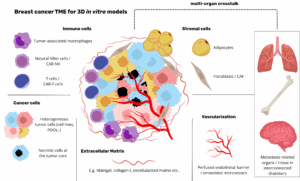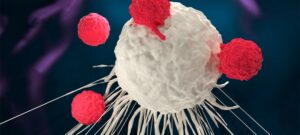Immune Checkpoint Modulators as an emerging therapy
Through this paper, Kim and colleagues highlight the way that immune checkpoint modulators are exploited by tumor cells to decrease immune activation and antigen recognition. Therefore, these checkpoint modulators can also be a powerful tool to improve cancer therapy. It is a non-specific strategy that consists of a generalized activation of the immune system that can be combined with chemotherapy and/or radiation therapy. Indeed, monoclonal antibodies such as anti-CTLA-4 (ipilimumab) and anti-PD-1 (nivolumab), can be used to target checkpoint inhibitors for a therapeutic blockade. Both are already in phase 4 of clinical development but there are many other targets known as LAG-3, TIM-3, KIR, and GITR which are in phase 1 or 2.

How to culture vascularized & immunocompetent 3D models in a standard Multiwell
Summary
Immune checkpoints have come to the forefront of cancer therapies as a powerful and promising strategy to stimulate antitumor T cell activity. Results from recent preclinical and clinical studies demonstrate how checkpoint inhibition can be utilized to prevent tumor immune evasion and both local and systemic immune suppression. This review encompasses the key immune checkpoints that have been found to play a role in tumorigenesis and, more specifically, gliomagenesis. The review will provide an overview of the existing preclinical and clinical data, antitumor efficacy, and clinical applications for each checkpoint with respect to GBM, as well as a summary of combination therapies with chemotherapy and radiation.
References
FAQ
Immune checkpoints are a component of the immune system. They have become a focus of cancer therapies because their inhibition can be used to stimulate T cell activity against a tumour. Tumour cells are known to exploit these checkpoints. This exploitation is done to reduce the activation of the immune system. It also helps the tumour cells decrease antigen recognition. When tumours use these checkpoints, they can achieve immune evasion. This mechanism helps the tumour to avoid being attacked by the body’s immune cells. Both local and systemic immune suppression can be a result of this tumour activity. By inhibiting these checkpoints, this tumour-induced suppression can be prevented.
A therapeutic strategy has been developed based on immune checkpoints. It is considered a promising approach. The main goal is the stimulation of T cell activity against the tumour. The strategy is described as non-specific. It consists of a generalised activation of the immune system. This approach uses checkpoint inhibition. This inhibition is able to prevent the tumour from evading the immune system. It also works to prevent local and systemic immune suppression caused by the tumour. The therapy often uses monoclonal antibodies. These antibodies are used to target the checkpoint inhibitors. This creates a therapeutic blockade, allowing the immune system to become more active against the cancer.
Monoclonal antibodies are one method used to target checkpoint inhibitors. This action results in a therapeutic blockade. Two examples of these antibodies are already in Phase 4 of clinical development. The first is anti-CTLA-4, which is also known as ipilimumab. The second is anti-PD-1, or nivolumab. In addition to these, many other targets are also being studied. These other targets are currently in earlier phases of development, such as Phase 1 or 2\. Examples of these targets include LAG-3, TIM-3, KIR, and GITR.
Immune checkpoint modulators are being examined as a therapy for gliomas. The role of immune checkpoints in gliomagenesis, which is the formation of gliomas, has been studied. Preclinical and clinical data are being reviewed. This information concerns the antitumour efficacy and clinical applications for checkpoints, specifically in relation to glioblastoma (GBM). This therapeutic strategy is not always used on its own. It is noted that the generalised activation of the immune system can be combined with other treatments. These other treatments include both chemotherapy and radiation therapy.





